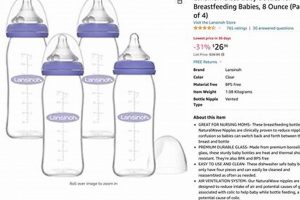Audible clicking noises emanating during infant bottle-feeding often indicate that the baby is not creating a secure seal around the bottle’s nipple. This imperfect latch allows air to enter the oral cavity as the infant attempts to suck, subsequently producing the distinct clicking. As an example, an observer might hear the clicking sound intensify when the babys position shifts slightly during a feeding session.
Recognition of the potential underlying causes and effects of this phenomenon is important for parental awareness and infant well-being. Frequent air intake while feeding can contribute to increased gas, discomfort, and fussiness in infants. Historically, various bottle and nipple designs have aimed to mitigate this air ingestion; current research continues to examine optimal feeding techniques to minimize associated issues.
The following sections will further examine common causes of audible clicks during bottle-feeding, provide techniques for improved latch and feeding posture, and offer guidance on when seeking professional consultation is advisable. These steps aim to optimize the feeding experience and promote infant comfort.
Addressing Clicking Sounds During Infant Bottle-Feeding
This section provides practical advice to minimize the occurrence of audible clicking during infant bottle-feeding, focusing on enhancing latch and feeding techniques.
Tip 1: Optimize Nipple Size and Flow Rate: A nipple with an inappropriate flow rate can disrupt the infant’s sucking coordination. A flow that is too rapid may cause the infant to gulp, increasing air ingestion. Consider a slower-flow nipple if the infant seems overwhelmed. Conversely, if the infant struggles to extract milk, a faster flow may be necessary.
Tip 2: Ensure Proper Latch Technique: Confirm the infant’s lips are flanged outwards around the base of the nipple, creating a tight seal. The nipple should extend far enough into the infant’s mouth. Gentle encouragement may assist in establishing a more secure latch.
Tip 3: Maintain Correct Bottle and Infant Positioning: Hold the bottle at an angle that keeps the nipple consistently filled with milk, minimizing air in the nipple. Elevate the infant’s head slightly during feeding to promote easier swallowing and reduce the risk of air intake.
Tip 4: Burp Frequently During and After Feeding: Regular burping helps expel accumulated air from the infant’s stomach, reducing discomfort and the likelihood of regurgitation. Pause feeding periodically to burp the infant, especially if clicking sounds are observed.
Tip 5: Consider Bottle and Nipple Design: Certain bottles are designed with venting systems to reduce air ingestion. Experiment with different bottle and nipple shapes to determine which best suits the infant’s individual needs and feeding style.
Tip 6: Observe for Signs of Nasal Congestion: Nasal congestion can impede the infant’s ability to breathe effectively while feeding, potentially leading to an imperfect latch and increased air intake. Address any nasal congestion with appropriate saline drops or nasal aspirators before feeding.
Optimal feeding outcomes rely on correct technique and awareness of contributing factors. Addressing the causes of audible clicks contributes to more comfortable and efficient feeding sessions.
The next segment will outline circumstances where seeking professional consultation may be appropriate.
1. Improper Latch
An improper latch during bottle-feeding is a significant contributor to the occurrence of audible clicking sounds. When an infant fails to establish a secure seal around the bottle’s nipple, air is drawn into the oral cavity alongside the milk. This introduction of air disrupts the feeding process and manifests as the characteristic clicking noise.
- Inadequate Lip Seal
The infant’s lips should flange outwards, creating a firm seal against the base of the nipple. If the lips are tucked inwards or are not fully encompassing the nipple’s base, air can leak in. For example, if the infant’s lower lip is drawn inwards, a gap forms, allowing air to enter with each suckling motion.
- Shallow Nipple Placement
The nipple should be positioned deeply enough within the infant’s mouth to engage the hard palate. A shallow latch, where only the tip of the nipple is in the mouth, prevents a proper seal. This can be observed when the infant appears to be chewing on the nipple rather than actively sucking.
- Tongue Position Interference
The infant’s tongue plays a crucial role in creating suction and maintaining the seal. If the tongue is positioned incorrectly, such as being bunched up or thrusting forward, it can disrupt the latch. An example includes the infant pushing the nipple out with their tongue, breaking the suction.
- Coordination Difficulties
Some infants, particularly newborns, may experience difficulty coordinating sucking, swallowing, and breathing. This can lead to inconsistent latching and frequent breaks in suction. The resulting start-and-stop pattern of feeding often leads to increased air ingestion and clicking sounds.
The identified facets highlight the importance of observing the infant’s latching technique closely. Identifying and correcting these issues can significantly reduce or eliminate audible clicking, promoting more efficient and comfortable feeding. Modifying the feeding position, adjusting the nipple size, and ensuring proper lip and tongue placement are key interventions.
2. Nipple Airflow
Nipple airflow characteristics significantly influence the dynamics of infant bottle-feeding, particularly concerning the occurrence of clicking sounds. The rate and consistency of milk flow through the nipple directly impact the infant’s ability to maintain a secure latch and coordinate sucking, swallowing, and breathing, thereby affecting air ingestion.
- Excessive Flow Rate
An excessively rapid flow rate overwhelms the infant’s capacity to manage the milk, often leading to gulping and an imperfect seal around the nipple. The infant may struggle to coordinate their sucking and swallowing, resulting in increased air intake and subsequent clicking sounds. Example: A newborn using a level 3 nipple designed for older infants may exhibit these symptoms.
- Insufficient Flow Rate
Conversely, a flow rate that is too slow can cause frustration and increased sucking effort. This intensified effort may inadvertently break the seal, allowing air to enter the mouth and produce clicking sounds. The infant may also tire quickly, further compromising the latch. Example: An older infant using a newborn nipple might struggle to extract milk, leading to an inconsistent latch.
- Inconsistent Flow
Variations in flow rate during feeding sessions disrupt the infant’s rhythm and contribute to an unstable latch. Sudden surges of milk may cause the infant to gasp, while periods of restricted flow can lead to increased sucking pressure, both potentially resulting in air ingestion. Example: A nipple with a partially blocked vent might exhibit erratic flow patterns.
- Nipple Venting System Functionality
Many modern bottles incorporate venting systems designed to equalize pressure inside the bottle, reducing vacuum formation and promoting consistent flow. A malfunctioning or absent venting system can cause the nipple to collapse, interrupting flow and forcing the infant to break the seal to allow air into the bottle. Example: A bottle with a clogged vent showing significant nipple collapse during feeding.
The observed interactions between nipple airflow dynamics and infant feeding patterns underscore the critical role of appropriate nipple selection. Ensuring a flow rate that aligns with the infant’s developmental stage and sucking capabilities is vital for minimizing air ingestion and preventing the production of audible clicking sounds. The functionality of the bottle’s venting system also plays a key role. Choosing the correct nipple and confirming the functionality of the venting mechanism are, therefore, crucial steps in addressing this phenomenon.
3. Bottle Angle
The inclination at which a bottle is held during infant feeding significantly influences the likelihood of audible clicking sounds. An improperly angled bottle introduces air into the nipple, disrupting the flow of milk and impacting the infant’s ability to maintain a secure latch. When the bottle is held too horizontally, the nipple is not consistently filled with milk, creating a vacuum that draws air into the infant’s mouth with each suckling motion. This ingested air subsequently generates the characteristic clicking sound. For example, if the bottle is nearly parallel to the floor, air occupies a significant portion of the nipple, resulting in frequent air ingestion and clicking.
Correct bottle angling ensures that the nipple remains consistently filled with milk, minimizing air ingestion and promoting a more continuous flow. This is achieved by holding the bottle at an angle that allows gravity to keep the milk at the tip of the nipple, even as the infant sucks. A practical demonstration involves observing the nipple during feeding; if a constant stream of milk is visible, the angle is likely adequate. Conversely, if air bubbles are frequently seen entering the nipple, the angle requires adjustment. Furthermore, the appropriate bottle angle can aid in managing instances of excessive or forceful let-down, preventing the infant from gulping and potentially reducing the incidence of air ingestion.
In summation, the careful management of bottle angle represents a readily controllable factor that can mitigate the occurrence of clicking sounds during infant feeding. By maintaining an angle that keeps the nipple consistently filled with milk, parents and caregivers can reduce air ingestion, promote a more secure latch, and enhance the overall feeding experience. Consistent attention to this detail contributes to improved infant comfort and feeding efficiency.
4. Nasal Congestion
Nasal congestion directly influences an infant’s ability to coordinate breathing, sucking, and swallowing during bottle-feeding, thereby predisposing them to audible clicking. The obstruction of nasal passages necessitates mouth breathing, which compromises the infant’s capacity to maintain a tight seal around the bottle nipple. This compromised seal allows air to enter the oral cavity, generating clicking sounds as the infant attempts to suckle. For example, an infant experiencing a common cold with significant nasal blockage may struggle to breathe nasally while feeding, instinctively opening the mouth wider to compensate, which disrupts the proper latch.
The degree of nasal congestion is proportional to the likelihood and intensity of clicking sounds. Mild congestion may only result in occasional clicks, whereas severe blockage almost invariably leads to persistent clicking throughout the feeding session. Managing nasal congestion through the use of saline drops and gentle nasal aspiration becomes a crucial element in minimizing air ingestion and optimizing the infant’s feeding efficiency. Furthermore, the infant’s postural adjustment to compensate for nasal obstruction may further impact the latch. To illustrate, the infant may tilt their head back or arch their neck, which in turn alters the oral anatomy and contributes to an inefficient seal around the nipple.
In summation, nasal congestion plays a significant role in the genesis of clicking sounds during bottle-feeding. Addressing nasal passages through appropriate methods can facilitate more efficient feeding, reduce air ingestion, and minimize discomfort for the infant. Recognizing the connection between nasal patency and successful latching is, therefore, essential for optimal infant care. The information is important to consider in broader discussions around improving feeding routines.
5. Tongue Position
Tongue position plays a critical role in the creation of a secure seal during bottle-feeding; an improper tongue posture directly contributes to the generation of audible clicking sounds. The infant’s tongue is essential for creating suction, controlling milk flow, and maintaining a stable latch on the bottle’s nipple. When the tongue is positioned incorrectly, it disrupts the negative pressure required for effective feeding, leading to air ingestion and the resultant clicking. For example, if the tongue is retracted or bunched up instead of cupped around the nipple, an incomplete seal is formed, permitting air to enter the oral cavity with each suckling motion.
Specific aberrant tongue positions include tongue thrusting, where the tongue pushes forward against the nipple, and tongue retraction, where the tongue is pulled back towards the throat. Both interfere with the proper latching mechanism. In cases of tongue-tie (ankyloglossia), the restricted movement of the tongue further exacerbates these issues, impeding the infant’s ability to create a suction seal. Furthermore, the clicking sound’s frequency and intensity often correlate with the severity of the tongue positioning issue. An infant with a pronounced tongue thrust may exhibit more frequent and louder clicking compared to an infant with subtle tongue retraction. Observational analysis of the infant’s tongue movement during feeding provides crucial diagnostic information and guides appropriate intervention strategies. Techniques such as positioning adjustments or specialized feeding therapies may be implemented to promote correct tongue placement and improve latch efficacy.
In summary, appropriate tongue positioning is indispensable for effective bottle-feeding and the avoidance of clicking sounds. A stable, cupped tongue posture supports proper suction, prevents air ingestion, and promotes efficient milk transfer. Recognizing and addressing tongue positioning issues, including potential underlying conditions like tongue-tie, is, therefore, paramount for optimizing infant feeding outcomes. These insights underscore the importance of a comprehensive assessment of oral motor function when addressing feeding difficulties.
Frequently Asked Questions
This section addresses common inquiries regarding the appearance of clicking sounds when a baby drinks from a bottle, offering concise and fact-based responses.
Question 1: What exactly causes the clicking sound heard during bottle-feeding?
The clicking sound typically results from air entering the oral cavity due to an imperfect seal between the infant’s lips and the bottle nipple. The influx of air, coupled with the sucking action, generates the distinct clicking noise.
Question 2: Is the clicking sound harmful to the infant?
The clicking sound itself is not directly harmful. However, it often indicates excessive air ingestion, which can lead to gas, discomfort, and increased fussiness in the infant. Chronic or severe air ingestion may require further evaluation.
Question 3: How can the incidence of the clicking sound be reduced?
Optimizing the infant’s latch, adjusting the bottle angle, selecting an appropriate nipple flow rate, and ensuring clear nasal passages can significantly reduce air ingestion and the associated clicking sound.
Question 4: Does the type of bottle used affect the likelihood of clicking sounds?
Certain bottle designs, particularly those with venting systems, are intended to minimize air ingestion. The selection of a bottle suited to the infant’s needs may influence the presence of clicking sounds.
Question 5: When is it appropriate to seek professional medical advice regarding clicking sounds during bottle-feeding?
If the clicking sound is persistent, accompanied by signs of discomfort (e.g., excessive gas, frequent spitting up, poor weight gain), or if there are concerns about the infant’s feeding skills, consultation with a pediatrician or lactation consultant is recommended.
Question 6: Can the infant outgrow the clicking sound issue?
As the infant develops improved oral motor skills and coordination, the clicking sound may naturally diminish. However, addressing underlying causes and employing correct feeding techniques are important to proactively minimize the issue.
Key takeaways emphasize the need for attentive observation during feeding sessions, the implementation of appropriate feeding techniques, and, when necessary, seeking guidance from qualified healthcare professionals.
The following sections will delve into resources for obtaining further assistance and support.
Concluding Remarks
The preceding discussion comprehensively explored the phenomenon of a clicking sound when baby drinks bottle, dissecting its causes from improper latch to nasal congestion and highlighting effective mitigation strategies. The analysis underscored that audible clicks are often symptomatic of underlying feeding inefficiencies rather than a direct cause for alarm.
Ultimately, heightened parental awareness, attentive observation of infant feeding cues, and the proactive implementation of recommended techniques represent the most effective approach. Persistent or concerning instances warrant professional assessment to ensure optimal infant health and development. Continued research promises further refinement in bottle and nipple design, alongside improved feeding practices that minimize the prevalence of this common occurrence.







